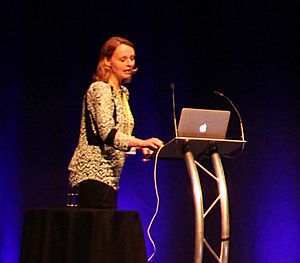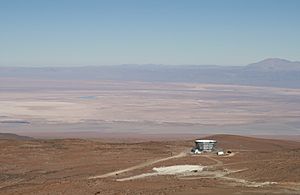Jo Dunkley facts for kids
Quick facts for kids
Jo Dunkley
|
|
|---|---|

Jo Dunkley delivering a plenary lecture in 2015
|
|
| Born |
Joanna Dunkley
1979/1980 (age 45–46) |
| Education | North London Collegiate School |
| Alma mater | University of Cambridge (MSci) University of Oxford (DPhil) |
| Partner(s) | Faramerz Dabhoiwala |
| Children | two |
| Awards |
|
| Scientific career | |
| Fields | Cosmology Cosmic microwave background Neutrinos |
| Institutions | Princeton University University of Oxford |
| Thesis | Modern methods for cosmological parameter estimation : beyond the adiabatic paradigm (2005) |
| Doctoral advisor | Pedro G. Ferreira |
| Notable students | Renée Hložek |
Joanna Dunkley is a British astrophysicist and a Professor of Physics. She teaches at Princeton University in the United States. Professor Dunkley studies the beginning of the Universe. She also researches the Cosmic microwave background (CMB). This is like an echo from the Big Bang. She uses powerful telescopes like the Atacama Cosmology Telescope to do her research.
Contents
Education and Early Career
Joanna Dunkley went to North London Collegiate School. She then studied at the University of Cambridge. In 2001, she earned a Master of Science degree there. This degree focused on Theoretical Physics. She was a student at Trinity Hall, Cambridge.
After Cambridge, she moved to Oxford for more studies. In 2005, she received her Doctor of Philosophy (DPhil) degree. Her research was guided by astrophysicist Pedro G. Ferreira. She was a postgraduate student at Magdalen College, Oxford.
Exploring the Universe
Professor Dunkley's main research area is Cosmology. This is the study of the Universe's history and future. She uses special telescopes to look at the early Universe. These include the Atacama Cosmology Telescope, the Simons Observatory, and the Large Synoptic Survey Telescope (LSST).
After her DPhil, she joined Princeton University in 2006. She worked as a postdoctoral research fellow. There, she collaborated with scientists like David Spergel and Lyman Page. They worked on NASA’s Wilkinson Microwave Anisotropy Probe (WMAP). This project helped map the early Universe.
A colleague, David Spergel, said she made big contributions. Her work helped create what we now call the standard model of cosmology. This model explains how the Universe works. Soon after, she started working with the European Space Agency (ESA) Planck satellite. This satellite gave an even clearer view of the cosmic microwave background (CMB).
In 2007, Professor Dunkley moved to Oxford. She became a Professor of Astrophysics in 2014. She led the analysis for the Atacama Cosmology Telescope in Chile. She used gravitational lensing to find dark matter. Gravitational lensing is when gravity bends light. Her work at Oxford also helped figure out the number of neutrinos in the world. Neutrinos are tiny particles.
The images of the CMB released in 2013 showed the Universe when it was very young. It was only about 400,000 years old then. Her research combines ideas from theoretical physics with statistical analysis. She uses her models to understand the Universe from observations. Professor Dunkley can estimate how much the Universe weighs. She can also find the amounts of dark energy and dark matter. She used gravitational lensing in the CMB to find evidence for dark energy. This was chosen as a highlight by Physics Today in 2011.
Professor Dunkley returned to Princeton in 2016. Her new research uses the Simons Observatory. She looks for "new physics" and extra particles. These might have existed when the Universe was very young. In 2017, she won the Breakthrough Prize for Physics. She shared it with 22 members of the NASA WMAP Science Team.
Sharing Science with Everyone
Professor Dunkley enjoys sharing her knowledge. She has given many public talks and seminars. She has appeared on BBC Stargazing Live. She was also on Dara Ó Briain's Science Club. Her first book, Our Universe: An Astronomer's Guide, was published in 2019. She plans to give workshops and talks for students. These will help raise awareness of women's contributions to astronomy.
Awards and Recognitions
Professor Dunkley has received many awards for her work:
- 2024 – Elected a Fellow of the Royal Society (FRS).
- 2020 – New Horizons in Physics Prize.
- 2019 – Appointed Order of the British Empire (OBE). This was for her services to Science.
- 2017 – Breakthrough Prize in Fundamental Physics. She shared this with the NASA WMAP Science Team.
- 2016 – Rosalind Franklin Award and Lecture.
- 2015 – Royal Society Wolfson Research Merit Award.
- 2015 – Awarded Philip Leverhulme Prize by the Leverhulme Trust.
- 2014 – Awarded the Fowler Prize by the Royal Astronomical Society (RAS).
- 2013 – Maxwell Medal and Prize.
- 2012 – Gruber Prize in Cosmology. She shared this with the WMAP team.
- 2010 – Starting grant from the European Research Council (ERC).
- 2007 – NASA Group Achievement Award. She shared this with the WMAP team.
Personal Life
Joanna Dunkley has two children. Her partner is the historian Faramerz Dabhoiwala.
See also
 In Spanish: Jo Dunkley para niños
In Spanish: Jo Dunkley para niños


